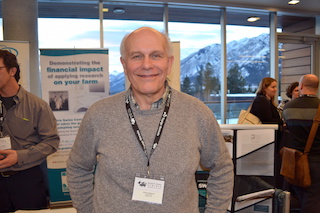
The Banff Pork seminar 2015, like the previous 43 years is a place to flush out the facts and the emotions in one way or the other.
Biosecurity is at the top of the list for everyone inside the industry and those on the outside looking in, who sometimes make contact with those on the inside.
That is one major issue and it looks like the industry is keeping on top of that one. The other one, especially in Canada, is the lack of finances, whether producer, banker, or both. In the banker’s case often a lack of will to pull the trigger. Many are still gun shy from the lean years, some calling them the ‘seven’ lean years.
In Saskatchewan, there is new funding to assist Saskatchewan pork producers in improving biosecurity to help prevent the spread of PED.
The governments of Saskatchewan and Canada have allocated $150,000 in funding through Growing Forward 2 to administer the Saskatchewan Swine Transport Biosecurity Program to help the province’s hog producers improve biosecurity.
Harvey Wagner, the producer’s services manager with the Saskatchewan Pork Development Board, says all CQA registered farms in Saskatchewan are eligible to participate.
While confusing at times, the Saskatchewan Swine Transportation Biosecurity Program is the newer version of the last two biosecurity programs.
“Included with this one is $300 per CQA farm for a veterinarian visit to the farm,” says Wagner. “So they can have a good look at the biosecurity protocols and see how the biosecurity is going on the farm and how it could be improved. The other part of it is up to $700 for transportation audits so this would be auditing trucks after post washing just to be sure their washing is adequate and if there’s some issues and how to address it, if they’re not satisfactory. That would be a number of washes, more than one.”
Most audits wouldn’t cost $700 so this would be probably numerous audits up to a value of $700 per farm. Producers are eligible for payments for truck wash audits and inspections done by approved auditors or inspectors between August 1, 2014 and July 31, 2015. They’ll approve applications on a first come first served basis, he added.
On the issue of hog barns and hog expansion in Saskatchewan, Wagner says Saskatchewan is building one hog barn and a few other people are looking at it. A colony is building the new 600 sow facility.
“There are some other farms thinking about expanding, but more like replacing barns getting tired,” he said. “But what we are seeing is producers who depopulated barns under the federal government’s transition program are repopulating.”
The barns producers depopulated, cleaned them up fairly well, still in passable shape needing to have a bit of tender care to bring them up to speed.
“My understanding from the operators is it could have been worse,” said Wagner. “They bought them in good condition and are operating them now. Sow numbers are picking up in the last two years coming on stream, going into these previously depopulated barns increasing sow numbers in Saskatchewan.”
Wagner thinks financing is a big issue in building new barns and even in refurbishing older ones.
“You have to have dollars, to build, and a new barn for sure, the cost of new barns is really, really high,” he said. “You need to have access to some capital to get some of these new barns going. Even to refurbish some of the other ones, there are still a few out there that could be brought back into production, perhaps.”
Wagner thinks the attitude going forward, should the opportunity present itself, are some more producers will move forward, at least up to the point of building new barns. Right now things are at a standstill.
“We’d like to see the industry build more barns, particularly finishing capacity would be nice to see,” he says. “What we need to see is some new entrants in one way, shape or another.”
While a good steady business model shipping weanlings south, in some ways he’d like to see producers finish them at home because they have the feed grains, space, packing capacity, but the lack of financing is holding that back. •
— By Harry Siemens




